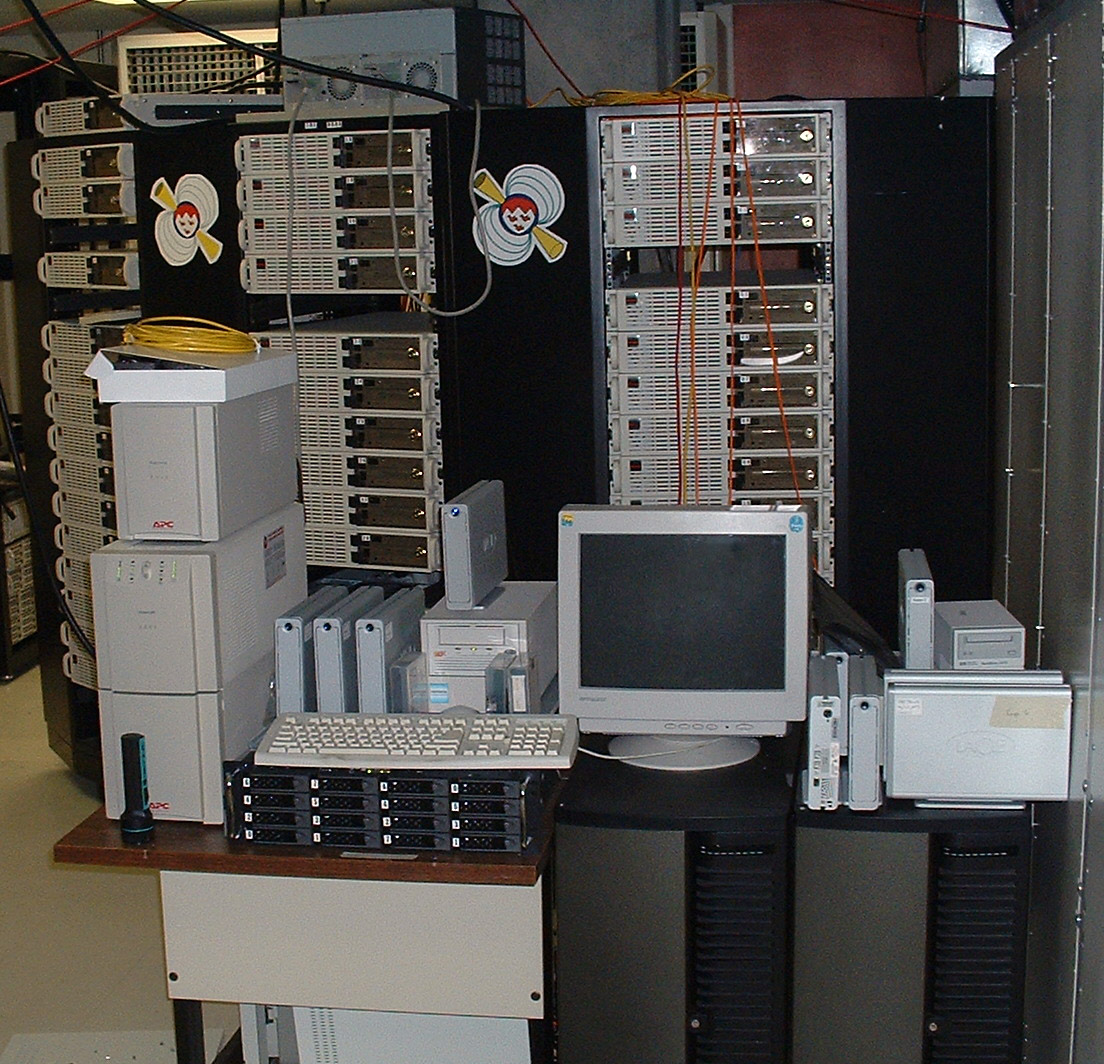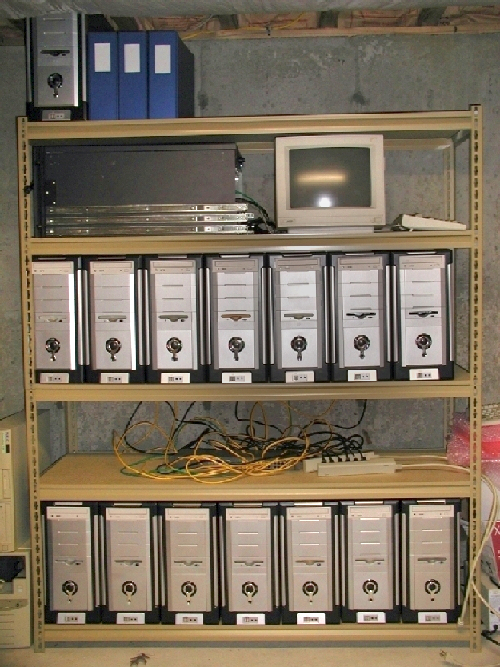Beowulf cluster on:
[Wikipedia]
[Google]
[Amazon]
 A Beowulf cluster is a computer cluster of what are normally identical, commodity-grade computers networked into a small
A Beowulf cluster is a computer cluster of what are normally identical, commodity-grade computers networked into a small
 A description of the Beowulf cluster, from the original "how-to", which was published by Jacek Radajewski and Douglas Eadline under the
A description of the Beowulf cluster, from the original "how-to", which was published by Jacek Radajewski and Douglas Eadline under the
 a number of Linux distributions, and at least one BSD, are designed for building Beowulf clusters. These include:
* MOSIX, geared toward computationally intensive, IO-low applications
* ClusterKnoppix, based on Knoppix
*
a number of Linux distributions, and at least one BSD, are designed for building Beowulf clusters. These include:
* MOSIX, geared toward computationally intensive, IO-low applications
* ClusterKnoppix, based on Knoppix
*
The Beowulf Cluster Site
*
A detailed description of building a Beowulf cluster
{{Authority control Cluster computing Parallel computing Job scheduling NASA spin-off technologies Unix software
 A Beowulf cluster is a computer cluster of what are normally identical, commodity-grade computers networked into a small
A Beowulf cluster is a computer cluster of what are normally identical, commodity-grade computers networked into a small local area network
A local area network (LAN) is a computer network that interconnects computers within a limited area such as a residence, school, laboratory, university campus or office building. By contrast, a wide area network (WAN) not only covers a larger ...
with libraries and programs installed which allow processing to be shared among them. The result is a high-performance parallel computing cluster from inexpensive personal computer
A personal computer (PC) is a multi-purpose microcomputer whose size, capabilities, and price make it feasible for individual use. Personal computers are intended to be operated directly by an end user, rather than by a computer expert or tec ...
hardware.
The name ''Beowulf'' originally referred to a specific computer built in 1994 by Thomas Sterling and Donald Becker at NASA
The National Aeronautics and Space Administration (NASA ) is an independent agencies of the United States government, independent agency of the US federal government responsible for the civil List of government space agencies, space program ...
. The name "Beowulf" comes from the Old English
Old English (, ), or Anglo-Saxon, is the earliest recorded form of the English language, spoken in England and southern and eastern Scotland in the early Middle Ages. It was brought to Great Britain by Anglo-Saxon settlers in the mid-5th c ...
epic poem of the same name.
No particular piece of software defines a cluster as a Beowulf. Typically only free and open source software
Free and open-source software (FOSS) is a term used to refer to groups of software consisting of both free software and open-source software where anyone is freely licensed to use, copy, study, and change the software in any way, and the source ...
is used, both to save cost and to allow customisation. Most Beowulf clusters run a Unix-like
A Unix-like (sometimes referred to as UN*X or *nix) operating system is one that behaves in a manner similar to a Unix system, although not necessarily conforming to or being certified to any version of the Single UNIX Specification. A Unix-li ...
operating system, such as BSD, Linux
Linux ( or ) is a family of open-source Unix-like operating systems based on the Linux kernel, an operating system kernel first released on September 17, 1991, by Linus Torvalds. Linux is typically packaged as a Linux distribution, w ...
, or Solaris. Commonly used parallel processing libraries include Message Passing Interface (MPI) and Parallel Virtual Machine
Parallel Virtual Machine (PVM) is a software tool for parallel networking of computers. It is designed to allow a network of heterogeneous Unix and/or Windows machines to be used as a single distributed parallel processor. Thus large computatio ...
(PVM). Both of these permit the programmer to divide a task among a group of networked computers, and collect the results of processing. Examples of MPI software include Open MPI
Open MPI is a Message Passing Interface (MPI) library project combining technologies and resources from several other projects (FT-MPI, LA-MPI, LAM/MPI, and PACX-MPI). It is used by many TOP500 supercomputers including Roadrunner, which was ...
or MPICH. There are additional MPI implementations available.
Beowulf systems operate worldwide, chiefly in support of scientific computing
Computational science, also known as scientific computing or scientific computation (SC), is a field in mathematics that uses advanced computing capabilities to understand and solve complex problems. It is an area of science that spans many disc ...
. Since 2017, every system on the Top500
The TOP500 project ranks and details the 500 most powerful non- distributed computer systems in the world. The project was started in 1993 and publishes an updated list of the supercomputers twice a year. The first of these updates always coinci ...
list of the world's fastest supercomputers has used Beowulf software methods and a Linux
Linux ( or ) is a family of open-source Unix-like operating systems based on the Linux kernel, an operating system kernel first released on September 17, 1991, by Linus Torvalds. Linux is typically packaged as a Linux distribution, w ...
operating system. At this level, however, most are by no means just assemblages of commodity hardware; custom design work is often required for the nodes (often blade servers), the networking and the cooling systems.
Development
Linux Documentation Project
The Linux Documentation Project (LDP) is a dormant an all-volunteer project that maintains a large collection of GNU and Linux-related documentation and publishes the collection online. It began as a way for hackers to share their documentation wi ...
in 1998:
Operating systems
 a number of Linux distributions, and at least one BSD, are designed for building Beowulf clusters. These include:
* MOSIX, geared toward computationally intensive, IO-low applications
* ClusterKnoppix, based on Knoppix
*
a number of Linux distributions, and at least one BSD, are designed for building Beowulf clusters. These include:
* MOSIX, geared toward computationally intensive, IO-low applications
* ClusterKnoppix, based on Knoppix
* Kerrighed
Kerrighed is an open source single-system image (SSI) cluster software project. The project started in October 1998 at the Paris research group The French National Institute for Research in Computer Science and Control. From 2006 to 2011, the pro ...
* Rocks Cluster Distribution
Rocks Cluster Distribution (originally NPACI Rocks) is a Linux distribution intended for high-performance computing (HPC) clusters. It was started by National Partnership for Advanced Computational Infrastructure and the San Diego Supercompute ...
* DragonFly BSD
DragonFly BSD is a free and open-source Unix-like operating system forked from FreeBSD 4.8. Matthew Dillon, an Amiga developer in the late 1980s and early 1990s and FreeBSD developer between 1994 and 2003, began working on DragonFly BSD in ...
* Quantian, a live DVD
A live CD (also live DVD, live disc, or live operating system) is a complete bootable computer installation including operating system which runs directly from a CD-ROM or similar storage device into a computer's memory, rather than loading fr ...
with scientific applications, based on Knoppix and ClusterKnoppix
* Kentucky Linux Athlon Testbed
* PelicanHPC
PelicanHPC is an operating system based on Debian Live, which provides a rapid means of setting up a high performance computer cluster.
PelicanHPC was formerly known as ParallelKNOPPIX.
Versions
References
External links
*
Opera ...
, based on Debian Live
Debian (), also known as Debian GNU/Linux, is a Linux distribution composed of free and open-source software, developed by the community-supported Debian Project, which was established by Ian Murdock on August 16, 1993. The first version of Deb ...
A cluster can be set up by using Knoppix bootable CDs in combination with OpenMosix. The computers will automatically link together, without need for complex configurations, to form a Beowulf cluster using all CPUs and RAM
Ram, ram, or RAM may refer to:
Animals
* A male sheep
* Ram cichlid, a freshwater tropical fish
People
* Ram (given name)
* Ram (surname)
* Ram (director) (Ramsubramaniam), an Indian Tamil film director
* RAM (musician) (born 1974), Dutch
* ...
in the cluster. A Beowulf cluster is scalable to a nearly unlimited number of computers, limited only by the overhead of the network.
Provisioning of operating systems and other software for a Beowulf Cluster can be automated using software, such as Open Source Cluster Application Resources. OSCAR installs on top of a standard installation of a supported Linux distribution on a cluster's head node.
See also
* Aiyara cluster * HTCondor * Grid computing * Kentucky Linux Athlon Testbed * Maui Cluster Scheduler * Open Source Cluster Application Resources *Stone Soupercomputer The Stone Soupercomputer was a Beowulf-style computer cluster built at the US Oak Ridge National Laboratory in the late 1990s.
A group of lab employees including William W. Hargrove and Forrest M. Hoffman applied for a grant to build a cluster in ...
* Sun Grid Engine
References
Bibliography
* ''Beowulf Cluster Computing With Windows'' by Thomas Lawrence Sterling 2001 MIT Press * ''Beowulf Cluster Computing With Linux'' by Thomas Lawrence Sterling 2001 MIT PressExternal links
The Beowulf Cluster Site
*
A detailed description of building a Beowulf cluster
{{Authority control Cluster computing Parallel computing Job scheduling NASA spin-off technologies Unix software